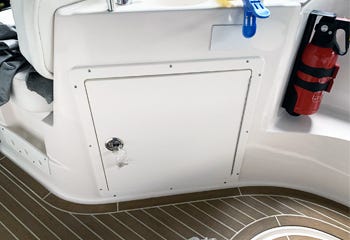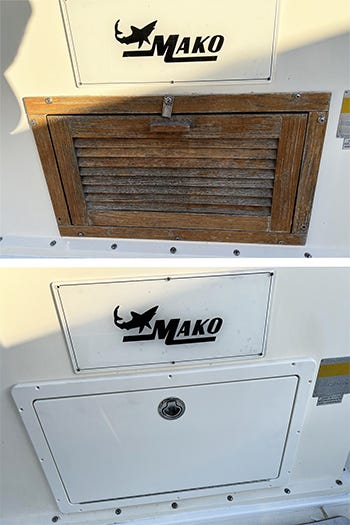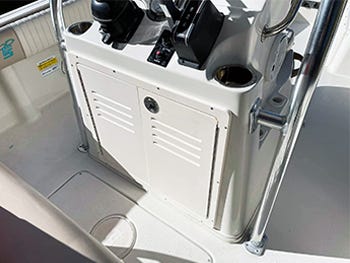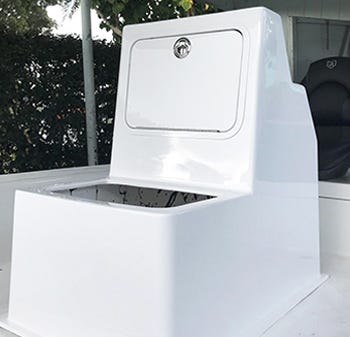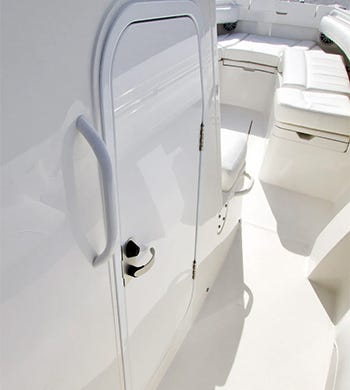

Whether you are simply replacing an old door on your boat or improving accessibility with a new or larger opening, a new boat door can enhance not only the functionality but also the look of your boat. As simple as a door might seem, however, there is a lot to consider.
This article will help you get the right fit, finish and functionality the first time. Here are some things to consider:
Contents
- 1. Door? Hatch? Lid? Plate?
- 2. When to Go Custom
- 2.1 Replacing An OEM door
- 2.2 Adding or Enlarging An Access Opening
- 3. Things to Know Before Your Start
- 3.1 Opening
- 3.2 Dimensions
- 3.3 Swing
- 3.4 Watch Those Curves
- 4. Choosing Your Materials
- 4.1 Aluminum (frame)
- 4.2 Starboard
- 4.3 Acrylic
- 4.4 Teak
- 4.5 Mica-Covered Birch Plywood
Door? Hatch? Lid? Plate?
One common misunderstanding is confusion between doors, hatches, lids and plates. Simply put, if you can stand on it, it isn’t a door. If you are dealing with a vertical or nearly vertical surface, it’s a door.
Most hatches are essentially heavy-duty doors designed to be walked on, and some are designed to be water-resistant.
Doors, on the other hand, may be water resistant but are rarely watertight, since their seals are recessed inside the frame. Lids, unlike doors and hatches, are typically frameless. Plates are typically smaller, round in shape and lack hinges. Instead, they screw or snap closed.
On a boat, “door” typically refers to covers for openings in vertical or nearly vertical surfaces. A “hatch,” on the hand, is in a horizontal surface and is usually designed to be walked on.
When to Go Custom
A wide variety of boat doors can be purchased off the shelf, but depending on what you are doing, a custom-made door may give you a better result.
The most common applications for this option are:
Replacing an OEM Door
For newer boats, it’s often possible to order exact replacement doors from the manufacturer or dealer. If not, Boat Outfitters, which supplies many boat manufacturers with their OEM doors, may have the design on file and be able to make a replacement.
If neither of those options is possible, though, getting an exact replacement for your OEM door will likely require a custom door to ensure the right fit.
Working from the old part — or even exact dimensions — Boat Outfitters can replicate virtually any boat door in King Starboard or marine acrylic.
Adding or Enlarging An Access Opening
In many cases, boat owners want to add or modify access to a console, bulkhead or other vertical surface to improve access or provide more storage.
A custom solution can ensure that the door is both functional and blends in with the rest of the boat.
Things to Know Before Your Start
Before you start cutting, modifying or designing, there are a lot of things to consider to ensure your new door provides the access you need.
By nature, boats have limited space, and the design of a door can either maximize that space, or be a major nuisance that renders a compartment nearly useless. Take time to consider these things before you order:
Opening
In order for a door to have any water or wind resistance, the cutout should allow for a frame to be mounted on all sides of the opening. A cutout that goes all the way to the floor of your boat, or that doesn’t allow a frame to be mounted on one side due to a curve in the area will not allow for a seal on that side.
The shape of the opening sometimes dictates hinge location. The farther hinges are from the ends of the door, the stiffer the panel material has to be.
Dimensions
There is more to a door than just height and width. The thickness of the material around the door may impact the material used for the frame and the thickness of the door itself. The shape of the opening will determine where the hinges need to be.
The shape of the opening will determine where the hinges need to be.
The larger the distance between hinges and the ends of the door, the stiffer the door material will need to be to avoid warping and a poor seal. It’s important to consider how a door will swing open. If swing space is limited — like between a console and leaning post — a double open out door may be required.
Swing
One of the most common mistakes when adding a door is not considering what is around the door when it is opened. Just about every imaginable flat surface on a boat has some obstacle that needs to be considered when designing a door. Take time to consider which way the door needs to swing to maximize access.
In some applications, a double open out door (a door that is essentially split in two and hinged on both sides) is required to reduce the swing radius. You may also need to consider a bi-fold door or one that can be quickly and completely removed — like a lift-out door — to allow the best access.
Watch those curves
A door requires a flat surface to create a good seal, but it is also important to remember that the frame requires the area to be flat as well. Don’t trust your eyes; take a straight edge and check the area before you cut. You may find curves you didn’t know were there. These curves should dictate the size of your opening.
While you may want to maximize the size of your opening to improve access, it is important to leave enough flat surface for the frame. Even the smallest curve will create an ugly gap on the outside of a frame, which has to be filled in or shimmed.
Choosing Your Materials
Boat doors are made in many different materials, including fiberglass, wood, various metals, Starboard, acrylic and various combinations of these materials. On most modern recreational boats, exterior door panels are made of either Starboard, acrylic or teak, with frames made of aluminum, teak or Starboard.
Each material has benefits and drawbacks to consider when designing your solution. Here is quick rundown of the things you want to keep in mind:
Aluminum (frame)
Powder-coated aluminum frame doors are more expensive than Starboard options, but offer a lower profile — just 1/8” proud of the mounting surface — and can be made with interior mounting holes so screw heads are hidden when the door is closed.
Powder-coated aluminum, though, isn’t well suited for openings where it’s likely to be “dinged” by metal on a regular basis — anchor lockers, for example. Once the powder coating is penetrated and saltwater reaches the aluminum underneath, corrosion can spread underneath the powder coating.
With their low profile design and hidden fasteners, powder-coated aluminum frames provide a clean, refined appearance.
Starboard
Starboard doors are generally less expensive than other materials, impervious to weather and nearly maintenance-free. Used in a frame, it is thicker than aluminum and cannot be mounted with hidden fasteners, so screw heads will be visible.
Starboard is available in a number of whites, off-whites, beiges and grays to match the gelcoat on most boats but is not as glossy as acrylic. Starboard is also more flexible than acrylic and may warp or bend in doors with long distances between the hinges and the ends of the door.
Acrylic
Acrylic can be clear, translucent or opaque and is available in a variety of colors. Its glossy finish resembles that of gelcoat. Acrylic is stiffer than Starboard, so a panel of the same size can be thinner and lighter. Its rigidity can also make it a good solution for odd shaped openings where hinges cannot be placed close to the ends of the door.
However, acrylic is significantly more expensive than Starboard and not as tough. It can be scratched and is susceptible to UV rays and certain cleaning chemicals over time.
Acrylic doors are more rigid for their thickness than Starboard doors and offer a glossy finish, similar to that of gelcoat.
Teak
For that classic look, it’s hard to beat teak wood, especially when matching other components of higher end or classic boats.
However, teak doors do do require more maintenance and may require thicker material than acrylic or Starboard.
Mica-Covered Birch Plywood
For interior doors that will not be exposed to elements — such as head and cabin doors — mica-covered birch ply doors can be made to match the boat’s interior and larger contours. They are also lighter than many other materials.
Whether it is a door, hatch, lid or panel, ensuring fit, functionality, and flow can maximize the storage space on your boat. Taking the time to consider all of these aspects will ensure that the custom solution you get is a perfect fit for your needs.

